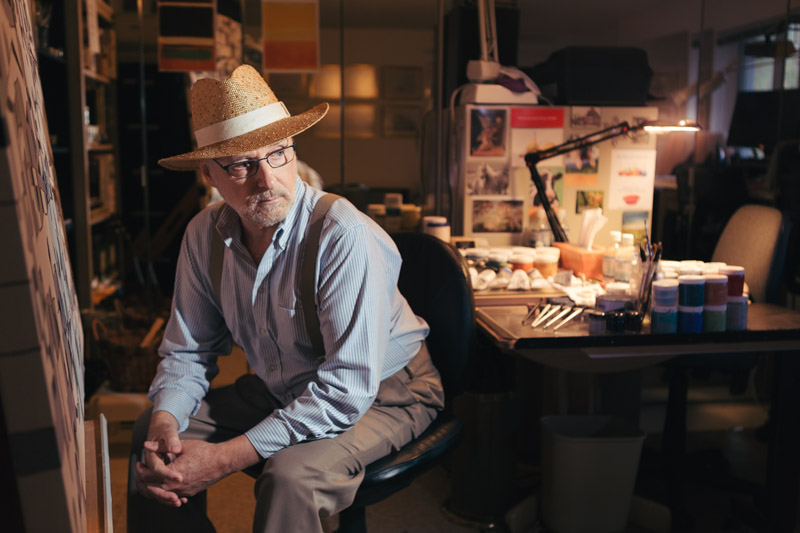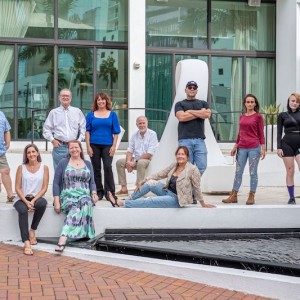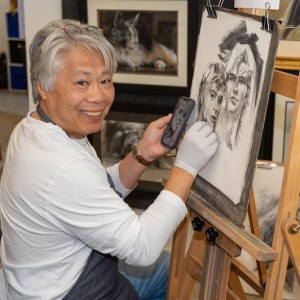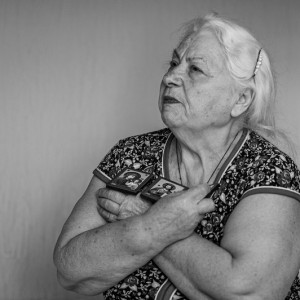“We all agree that this is a banana.”
Standing in his home-studio, artist Andrew Kuziak explains his conception of time. Slicing away a portion of the soft yellow fruit, he holds it up. This, we agree, is not a banana. “If you look at me, all you’re seeing is a cross-section of me,” says Kuziak, motioning with his bit of banana.
Kuziak has for some time been fascinated with the idea of time as the fourth dimension and our existence not as linear beings stepping into and changing with the flow of time, but as beings who can only be understood in our entirety across time. The you at 18 is not distinct from the you at 48, not an older and changed you, but disparate pieces of the greater whole that is the self.
It is this perception that guides Kuziak’s work and the experience that he strives to impress upon his audience with a style he has dubbed Four-Dimensional Abstract Art. To illustrate this perception, Kuziak often chooses highly active and energetic scenes–boxing bouts, football frenzies and samurai swordfights–for his compositions, depicting the entire event, all four dimensions, in one two-dimensional snapshot. Defying the scientific adage forbidding two objects to occupy the same space at the same time, Kuziak’s figures overlap and interplay–they share the same space because they are the same moment, the beginning is not separate from the end any more than an arm is separate from a leg in our understanding of the human form.
A crude approximation of the effect would be to imagine overlaying still-shots of an event and painting all the conflicting moments onto one canvas, capturing the entirety of the event in one moment of perception, transforming the river of time into a roiling eddy.
But growing up on a Pennsylvania farm and studying architecture and design through his youth, this is not the understanding Kuziak was born with. In the tradition of great storytelling, everything changed in an instant.
“I had an experience where there was no time and I’m attempting to create that in painting,” says Kuziak. “Trying to portray that experience in a visual manner.”
Standing outside the John Paul Getty Museum in Los Angeles, a young Kuziak admires a painting through the window. He begins to see lines of light connecting the people around him, connecting the paintings and the rooms and the great Oriental rug upon which they stand. Kuziak wanders through the gallery, room to room, following the lines and watching the criss-cross of energy and light. Through this experience, the interconnectivity of life is revealed, the wholeness of existence is made apparent. More than a little taken aback, Kuziak checks his watch and realizes that not a second has passed.
Kuziak wouldn’t speak of that ‘moment’ for 25 years, though he had similar experiences twice more, both seven years apart, sending him down the rabbit hole to the world where Platonic theory and quantum physics marry in a great striving to uncover the most fundamental secrets of our bizarre existence.
Today, the studio is full of Platonic models and sketches, Kuziak’s endeavors to mine answers from ancient wisdom. Mathematical and scientific texts sprawl across tables, riddled with notes and marginalia. The banana is child’s play, a prop brought to the stage for a newcomer. Kuziak has graduated to something greater. The best evidence of this lies apparent on the countless canvases that litter the Kuziak home, a testament to the artist’s earnest quest for understanding.
At first glance, laid upon easels in grand triptychs in the living room, the work seems chaotic. Appearing both highly geometric and undeniably organic, the forms and lines reveal their secrets, fittingly, through time. Looking at a Kuziak creation is akin to looking at a Magic Eye, in the sense that the image requires patience to fully experience. But Kuziak’s creations are no cheap optical illusions; they are carefully crafted still-life representations of the fourth dimension, waiting to be unpacked by the discerning eye.
It begins with a sketch, Kuziak’s architectural background lending speed and a trained eye for composition. The subjects move as he draws, an annoyance for most but exactly what Kuziak, looking for the entirety of the moment, wants. Once completed, his painting will tell a story and he speaks of the individual pieces–a certain line or shape–as words. These words form paragraphs, which in turn form the story of the work. The individual pieces jockey for position in the mind and the eye, forms emerge and play off one another in a frenetic attempt to capture that elusive moment of understanding, that moment when it all makes sense, when time stops. “Can I make a work of art that people will look at that eventually brings them to that state?” wonders Kuziak. “We all have that state in us–Plato says we have that in us–we just have to go back and remember.”

PHOTOGRAPHY BY SENIOR PHOTOGRAPHER EVAN SIGMUND










